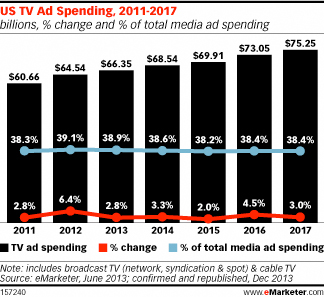Total Media Ad Spend Continues Slow and Steady Trajectory
December 30, 2013
![]() US total media ad spending will reach $171.33 billion in 2013, up 3.8%, or more than $6 billion, from 2012. eMarketer expects a slight uptick in spending in 2014 as well, as marketers allocate more dollars toward the FIFA World Cup soccer tournament, the Winter Olympics and the US midterm elections. Mobile ad investments will continue to fuel growth, according to our latest forecast and the new eMarketer report, “US Ad Spending: 2013 Year-End Forecast and Comparative Estimates.”
US total media ad spending will reach $171.33 billion in 2013, up 3.8%, or more than $6 billion, from 2012. eMarketer expects a slight uptick in spending in 2014 as well, as marketers allocate more dollars toward the FIFA World Cup soccer tournament, the Winter Olympics and the US midterm elections. Mobile ad investments will continue to fuel growth, according to our latest forecast and the new eMarketer report, “US Ad Spending: 2013 Year-End Forecast and Comparative Estimates.”
 In August 2013, eMarketer anticipated that paid media outlays by US advertisers would rise 3.6% in 2013 to total $171.01 billion. Higher-than-expected spending on digital and mobile ad formats for 2013 led to the increase in this forecast.
In August 2013, eMarketer anticipated that paid media outlays by US advertisers would rise 3.6% in 2013 to total $171.01 billion. Higher-than-expected spending on digital and mobile ad formats for 2013 led to the increase in this forecast.
 TV will continue to be the top recipient of ad investments through the end of the forecast period. Though expenditures are set to climb from $66.35 billion to $75.25 billion between 2013 and 2017, TV’s portion of total ad spending will drop from 38.7% to 37.9% during these years, as digital ad spending grows more quickly. In 2013, for the first time, spending by advertisers on television will have increased more slowly than total spending on paid media.
TV will continue to be the top recipient of ad investments through the end of the forecast period. Though expenditures are set to climb from $66.35 billion to $75.25 billion between 2013 and 2017, TV’s portion of total ad spending will drop from 38.7% to 37.9% during these years, as digital ad spending grows more quickly. In 2013, for the first time, spending by advertisers on television will have increased more slowly than total spending on paid media.
As for the rest of the traditional media world, the picture is a bit less rosy. Spending on newspaper, magazine and directory ads will decline through 2017, while growth of over-the-air radio ad expenditures will be relatively flat. Outdoor ad spending in the US will rise just above the 3.8% average gain for paid media ad dollars in 2013, at 4.2%.
eMarketer bases all of our forecasts on a multipronged approach that focuses on both worldwide and local trends in the economy, technology and population along with company-, product-, country- and demographic-specific trends as well as trends in specific consumer behaviors. We analyze quantitative and qualitative data from a variety of research firms, government agencies, media outlets and company reports, weighting each piece of information based on methodology and soundness.
Additionally, every element of each eMarketer forecast fits within the larger matrix of all our forecasts, with the same assumptions and general framework used to project figures in a wide variety of areas. Regular re-evaluation of each forecast means those assumptions and framework are constantly updated to reflect new market developments and other trends.
Courtesy of eMarketer





























